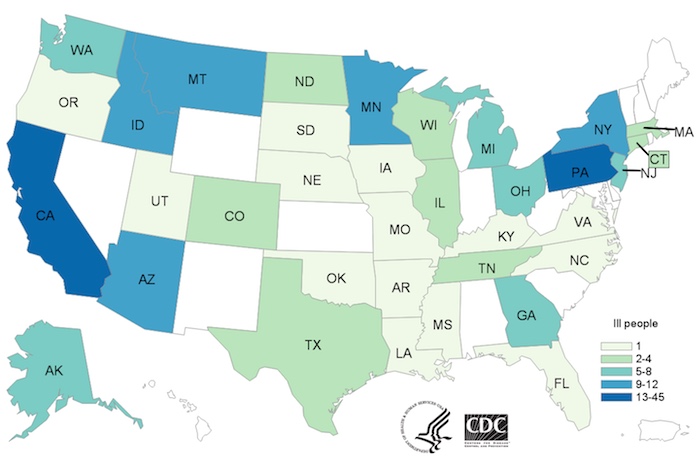The huge and deadly E. coli O157:H7 HUS outbreak that is linked to romaine lettuce has grown to include 197 people sick. Of those, 89 people have been hospitalized, and 26 have developed hemolytic uremic syndrome. And five people are now dead.

Twenty-five more ill persons have been added to the case count number since the last update on May 16 2018. Three more states have been added: Arkansas, North Carolina, and Oklahoma. The deaths are from Arkansas (1), Minnesota (2), and New York (1). The other person who died lives in California.
The case count by state is: Alaska (8), Arkansas (1), Arizona (9), California (45), Colorado (3), Connecticut (2), Florida (1), Georgia (5), Idaho (11), Illinois (2), Iowa (1), Kentucky (1), Louisiana (1), Massachusetts (4), Michigan (5), Minnesota (12), Mississippi (1), Missouri (1), Montana (9), Nebraska (1), New Jersey (8), New York (10), North Carolina (1), North Dakota (3), Ohio (7), Oklahoma (1), Oregon (1), Pennsylvania (24), South Dakota (1), Tennessee (3), Texas (3), Utah (1), Virginia (1), Washington (7), and Wisconsin (3). The patient age range is from 1 to 8 8years. Sixty-eight percent of those sickened are female.
Fred Pritzker, a lawyer who is representing clients sickened in this outbreak, said, “All consumers should be careful about the lettuce they buy, and all restaurants need to make sure that the food they serve is safe to eat.”
The hospitalization rate for this outbreak is very high at 48%. And the number of people who have developed HUS is also high, at 26. The typical number of HUS cases in an E. coli O157:H7 outbreak is about 5 to 10%.
The growing season in Yuma, Arizona, where officials believe the contaminated lettuce was grown, has been over for more than a month. Romaine lettuce has a shelf life of 21 days. The most recent case started on May 6, 2018. That means that the lettuce was most likely contaminated even at the very end of the growing season.
As before, a large percentage, 89%, of people interviewed said they ate romaine lettuce the week before they got sick. That is much higher than the results of a survey of healthy people in which 46% said they ate romaine lettuce the week before.
Some food safety experts thought the outbreak would be declared over by now, but it hasn’t. Most of the people who got sick recently ate romaine lettuce in restaurants and stores. And there has been person-to-person transmission in this outbreak; some people who got sick didn’t eat romaine, but had close contact with someone who did get sick from romaine lettuce.
Officials are saying that it is “unlikely” that any romaine lettuce from Yuma is still in stores or restaurants. They still say that it’s a good idea to ask where the romaine you may buy or eat comes from to confirm it is not from Yuma. Consumers should also know that washing lettuce will not remove pathogenic bacteria. And always wash your hands before preparing food, serving food, using the bathroom, or taking care of someone who is sick.
Lawsuits have been filed against Red Lobster, Panera, Texas Road House, and Papa Murphy’s restaurants across the country. Read more about suing restaurants for food poisoning.
The Minneapolis law firm of Pritzker Hageman represents and helps people who have been sickened by contaminated food such as contaminated produce. We get answers, compensation for those who have been injured, and justice through our work. Our lawyers represent clients and families of children who have been sickened with infections in personal injury and wrongful death lawsuits against growers, distributors, retailers, grocery stores, food processors, restaurants, and others. IN 2016, attorney Fred Pritzker and his team won a $7.5 million judgment for a young client whose kidneys failed because of hemolytic uremic syndrome after an E. coli O157:H7 infection. Please note that class action lawsuits are typically not appropriate for outbreak victims because these types of cases are very unique.




